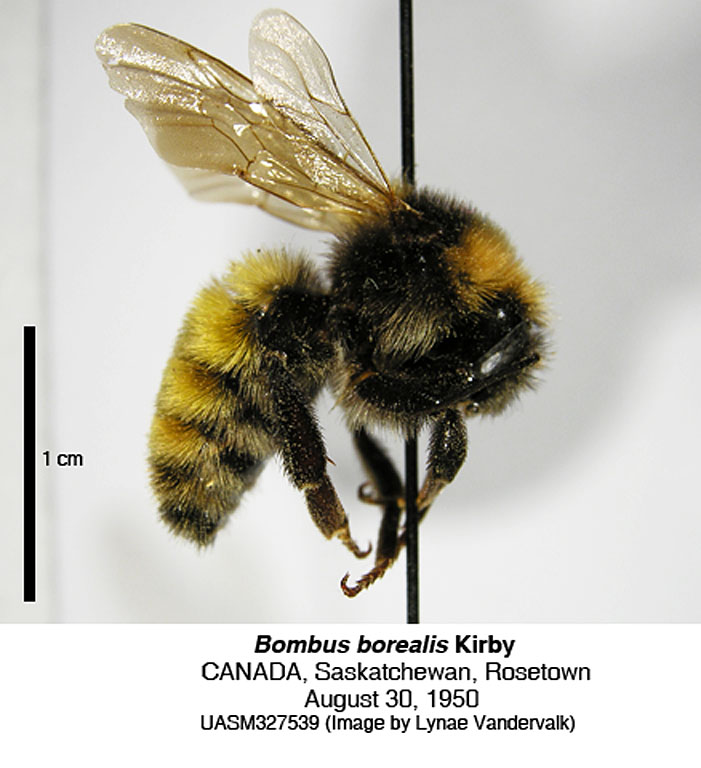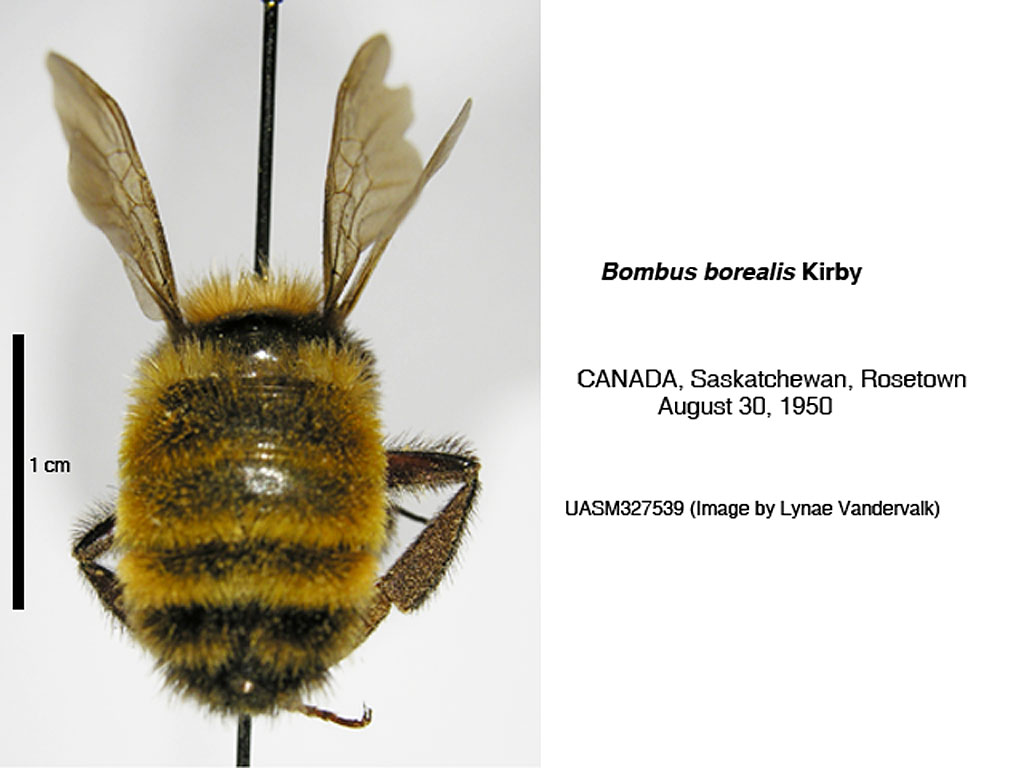« Back to your search
Species Details
Bombus borealis
University of Alberta E.H. Strickland Entomological Museum Read more about this collection »
SeasonalityAmong the latest of Bombus species to emerge from hibernation and establish nests in spring (Hobbs 1966).
IdentificationBombus borealis belongs to the subgenus Subterraneobombus in which females can be distinguished by small ocelli at the supraorbital line (Thorp et al. 1983), while males can be distinguished by spoon-shaped penis valvesthat are turned inwardsas well as the presence of a raised longitudinal keel posteriorly on sternum 6 (Williams et al. 2008)B. borealis individuals have white pile on the face between the eyes;the fifth antennal segment is longer than the fourth or third;the first four abdominal segments are covered with yellow pile, while the remaining segments are black;and the outer surface of the male hind tibia is concave (Franklin 1912).
The length of the queen varies from 15 mm to 19 mm; her wing spread from 32 mm to 39 mm; and the width of the second abdominal segment 8 mm to 9.5 mm. Workers vary in length from 10 mm to 15 mm; in wing spread from 26 mm to 32 mm; and in width of the second abdominal segment from 6.5 mm to 8 mm. Males range in length from 12 mm to 15 mm; in wing spread from 26 mm to 31 mm; and in width of second abdominal segment from 6 mm to 7.5 mm (Franklin 1912).
Scientific Name
Bombus borealis
Habitat
Prairie habitats with surface and underground nests (Hobbs 1966).
Seasonality
Among the latest of Bombus species to emerge from hibernation and establish nests in spring (Hobbs 1966).
Identification
Bombus borealis belongs to the subgenus Subterraneobombus in which females can be distinguished by small ocelli at the supraorbital line (Thorp et al. 1983), while males can be distinguished by spoon-shaped penis…
Bombus borealis belongs to the subgenus Subterraneobombus in which females can be distinguished by small ocelli at the supraorbital line (Thorp et al. 1983), while males can be distinguished by spoon-shaped penis valvesthat are turned inwardsas well as the presence of a raised longitudinal keel posteriorly on sternum 6 (Williams et al. 2008)B. borealis individuals have white pile on the face between the eyes;the fifth antennal segment is longer than the fourth or third;the first four abdominal segments are covered with yellow pile, while the remaining segments are black;and the outer surface of the male hind tibia is concave (Franklin 1912).
The length of the queen varies from 15 mm to 19 mm; her wing spread from 32 mm to 39 mm; and the width of the second abdominal segment 8 mm to 9.5 mm. Workers vary in length from 10 mm to 15 mm; in wing spread from 26 mm to 32 mm; and in width of the second abdominal segment from 6.5 mm to 8 mm. Males range in length from 12 mm to 15 mm; in wing spread from 26 mm to 31 mm; and in width of second abdominal segment from 6 mm to 7.5 mm (Franklin 1912).
Life History
Alford (1975) outlines the life history of Bombus borealis. Newly mated B. borealis queens overwinter beneath the soil litter and emerge from their hibernacula in late spring. Queens are transitory for a time, growing…
Alford (1975) outlines the life history of Bombus borealis. Newly mated B. borealis queens overwinter beneath the soil litter and emerge from their hibernacula in late spring. Queens are transitory for a time, growing in size while collecting pollen and looking for a suitable nest. Once a suitable nest has been found, the queen constructs an apple sized hollow structure within it. The queen deposits her eggs within a mound of pollen on the floor of the structure; she also constructs a honeypot for storing nectar. Newly hatched larvae begin consuming the pollen mound, requiring the queen to continue provisioning it. The queen periodically incubates her brood by sitting upon it and respiring to generate body heat. The larvae spin cocoons in the final instars, as do the pupa; the cocoons may be re-used later for storage of pollen or nectar. Upon pupation, the emerged adults take nectar from the honey pot. Once the nest consists of the new young workers and the queen it can be considered a social unit and is referred to as a colony. Subsequent generations are produced differently from the first: new eggs are laid in clumps in cells atop the pupating first generation of workers, and workers are now responsible for provisioning of the growing larva and the honey pot. The caste differentiation of each generation varies throughout the year, with the first generations containing all workers, followed by a worker/male split, followed by mostly males, followed by a male/queen split, followed by mostly queens. The factor initiating queen production has not been established but it appears the colony must reach a size capable of maintaining nest temperatures and food stores before queens are produced. Young queens remain in the colony and will mate during their first week. Males leave the hive and do not return; they establish a methodical flight path and mate with encountered queens. Hobbs (1966) reported that males of B. borealis will attempt to mate with queens in the nest, a behaviour seen in select other Bombus subgenera. Only the newly mated queens will overwinter in hibernacula; males, founder queens, and all workers perish.
Conservation
Of concern, populations appear to be declining (Grixti et al. 2009).
Diet Info
Largely unknown; queens have been observed foraging on wild licorice, Glycyrrhizalepidotaof the family Leguminosae (Hobbs 1966).
Range
Western and eastern neartic regions (Williams 1998).
References
Author
Williams, P.H., Cameron, S.A., Hines, H.M., Cederberg, B., Rasmont, P.
Title
A simplified subgeneric classification of the bumblebees (genus Bombus).
Publication Date
2008
Series Title
Apidologie
Volume
39
Pages
46-74
Author
Williams, P. H.
Title
An annotated checklist of bumble bees with an analysis of patterns of description (Hymenoptera: Apidae, Bombini).
Publication Date
1998
Series Title
Bulletin of the British Museum (Natural History) Entomology
Volume
67
Pages
79-152
Author
Thorp, R. W., D. S. Horning Jr. and L. L. Dunning
Title
Bumble bees and cuckoo bumble bees of California (Hymenoptera: Apidae).
Publication Date
1983
Series Title
Bulletin of the California Insect Survey
Volume
23
Pages
viii + 79 pp.
Author
Alford, D. V.
Title
Bumblebees.
Publication Date
1975
Pages
352
Author
Grixti, J.C., Wong, L.T., Cameron, S.A., Favret, C.
Title
Decline of bumble bees (Bombus) in the North American Midwest.
Publication Date
2009
Series Title
Biological Conservation
Volume
142
Pages
75-84
Author
Hobbs G. A.
Title
Ecology of species of Bombus Latr. (Hymenoptera, Apidae) in southern Alberta. V. Subgenus Subterramobombus Vogt.
Publication Date
1966
Series Title
The Canadian Entomologist
Volume
98
Pages
288-294
Author
Colla, S.R., Packer, L.
Title
Evidence for decline in eastern North American bumblebees (Hymenoptera: Apidea), with special focus on Bombus affinis Cresson.
Publication Date
2008
Series Title
Biodiversity and Conservation
Volume
17
Pages
1379-1391
Author
Franklin H. J.
Title
The Bombidae of the New World, part I.
Publication Date
1912
Series Title
Transactions of the American Entomological Society
Volume
38
Pages
177– 486
Specimen Information
There are 92 specimens of this Species.
UASM327547 - Bombus borealis
University of Alberta E.H. Strickland Entomological Museum
Place CollectedCanada: Alberta, Opal
Collected ByHocking, B.
Date Collected1955-08-09
UASM327548 - Bombus borealis
University of Alberta E.H. Strickland Entomological Museum
Place CollectedCanada: Alberta, Opal
Collected ByHocking, B.
Date Collected1955-08-09
UASM327549 - Bombus borealis
University of Alberta E.H. Strickland Entomological Museum
Place CollectedCanada: Alberta, Perryvale
Collected ByHocking, B.
Date Collected1956-09-20
UASM327550 - Bombus borealis
University of Alberta E.H. Strickland Entomological Museum
Place CollectedCanada: Alberta, Nordegg
Collected ByHocking, B.
Date Collected1955-07-10
UASM327551 - Bombus borealis
University of Alberta E.H. Strickland Entomological Museum
Place CollectedCanada: Alberta, Abee
Collected ByHoreczko, N.
Date Collected1957-05-25
UASM327552 - Bombus borealis
University of Alberta E.H. Strickland Entomological Museum
Place CollectedCanada: Alberta, Abee
Collected ByHoreczko, N.
Date Collected1957-06-10
UASM327553 - Bombus borealis
University of Alberta E.H. Strickland Entomological Museum
Place CollectedCanada: Alberta, Abee
Collected ByHoreczko, N.
Date Collected1957-06-10
UASM327554 - Bombus borealis
University of Alberta E.H. Strickland Entomological Museum
Place CollectedCanada: Ontario, Ottawa
Collected ByGibson, A.
Date Collected1905-07-28
UASM327555 - Bombus borealis
University of Alberta E.H. Strickland Entomological Museum
Place CollectedCanada: British Columbia, Summerland
Collected BySlabyj, B. M.
Date Collected1957-08-15
UASM327556 - Bombus borealis
University of Alberta E.H. Strickland Entomological Museum
Place CollectedCanada: Alberta, Golden Spike
Collected ByMaclean, V.
Date Collected1957-07-11
UASM327557 - Bombus borealis
University of Alberta E.H. Strickland Entomological Museum
Place CollectedCanada: Alberta, George Lake
Date Collected1965-07-25
UASM327558 - Bombus borealis
University of Alberta E.H. Strickland Entomological Museum
Place CollectedCanada: Alberta, Edmonton
Collected ByRyan, L. B.
Date Collected1956-10-02
UASM327559 - Bombus borealis
University of Alberta E.H. Strickland Entomological Museum
Place CollectedCanada: Alberta, Edmonton
Collected ByCallaghan, W. O.
Date Collected1956-09-20
UASM327560 - Bombus borealis
University of Alberta E.H. Strickland Entomological Museum
Place CollectedCanada: Alberta, Lethbridge
Collected ByLarson, D.
Date Collected1959-07-10
UASM327561 - Bombus borealis
University of Alberta E.H. Strickland Entomological Museum
Place CollectedCanada: Alberta, Lethbridge
Collected ByDavid, L.
Date Collected1956-08-16
UASM327562 - Bombus borealis
University of Alberta E.H. Strickland Entomological Museum
Place CollectedCanada: Alberta, Lethbridge
Collected ByDavid, L.
Date Collected1958-11-03
UASM327563 - Bombus borealis
University of Alberta E.H. Strickland Entomological Museum
Place CollectedCanada: Alberta, Lethbridge
Collected ByLarson, D.
Date Collected1960-07-20
UASM213644 - Bombus borealis
University of Alberta E.H. Strickland Entomological Museum
Place CollectedCanada: Alberta, Rowley
Collected ByAnweiler, G. G.
Date Collected2012-07-21
UASM213645 - Bombus borealis
University of Alberta E.H. Strickland Entomological Museum
Place CollectedCanada: Alberta, Rowley
Collected ByAnweiler, G. G.
Date Collected2012-07-21
UASM213646 - Bombus borealis
University of Alberta E.H. Strickland Entomological Museum
Place CollectedCanada: Alberta, Rowley
Collected ByAnweiler, G. G.
Date Collected2012-07-21
UASM213661 - Bombus borealis
University of Alberta E.H. Strickland Entomological Museum
Place CollectedCanada: Alberta, Edmonton
Collected ByAnweiler, G. G.
Date Collected2012-09-24



